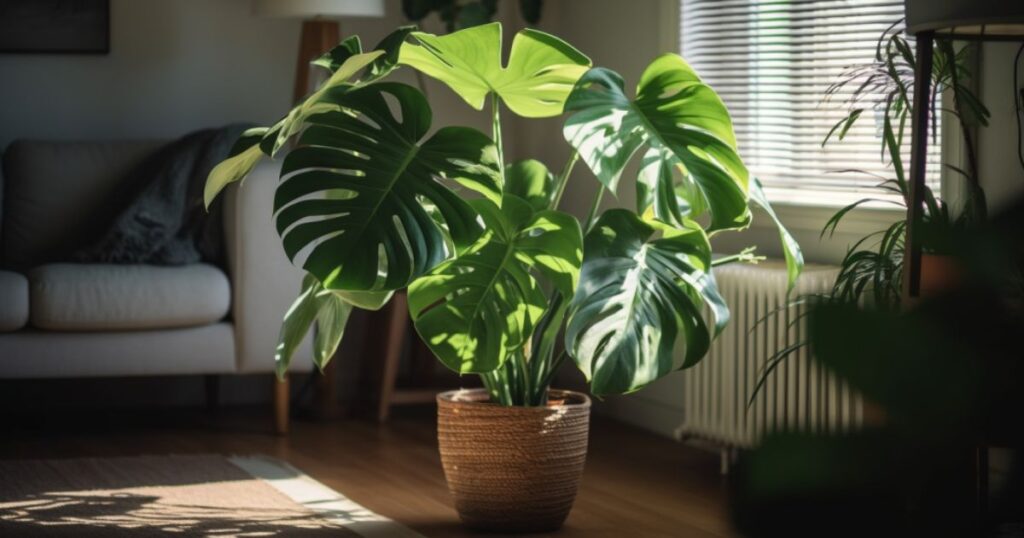
How To Propagate Monstera Plants: Your Easy Guide
Learn How To How To Propagate Monstera Plants From A Gardening And Propagation Expert Who Specializes In Helping New Gardeners

Do you love the graceful foliage with its eye-catching holes and the tropical aerial roots of the Monstera deliciosa ( Split-leaf philodendron ) as much as I do?
Did you know that this popular indoor plant, with just a little bit of effort, can be multiplied into an endless supply of baby Monstera plants?
This step-by-step guide is easy to follow and does not require you to be a master gardener to understand this simple propagation process.
By the end of this article, you will be an expert at propagating all varieties of Philodendron (Monstera) – also known as the Swiss Cheese Plant, due to the holes found in a Monstera leaf.
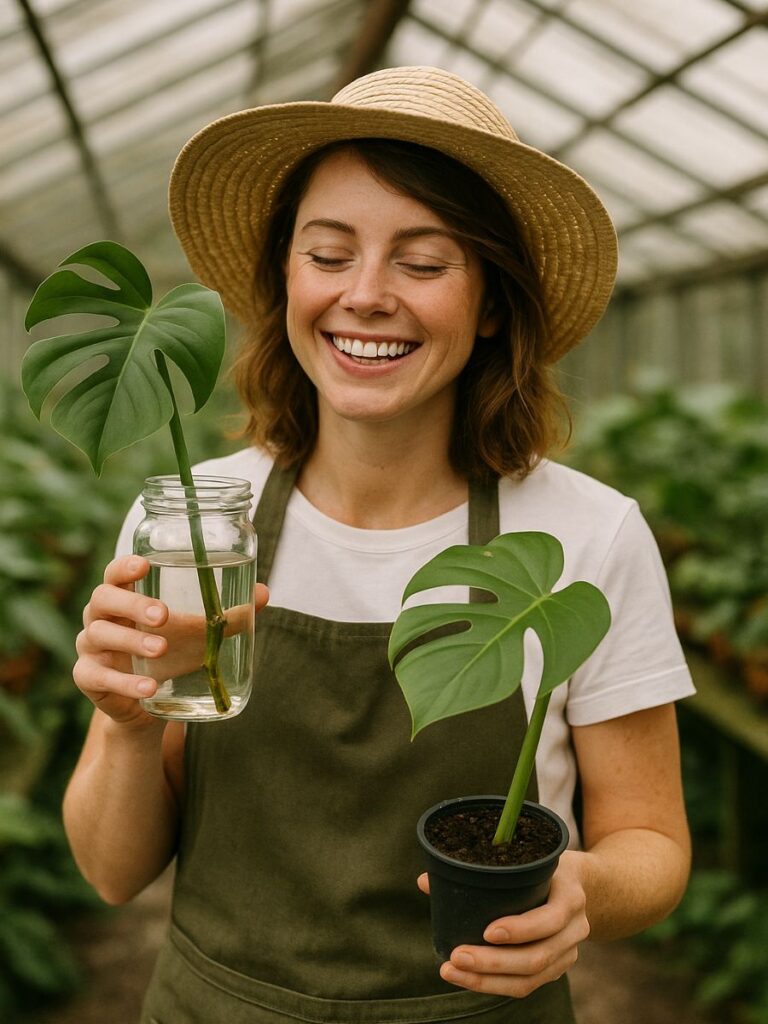
Propagating Monstera Plants
The tropical climbing Monstera adds botanical elements that are both architectural and graceful to any space. This striking plant is both easy to grow and easy to propagate. By following these simple steps, you can multiply your Monstera into enough new plants to fill your home and have plenty more to share with your friends and neighbors.
Propagation Methods
There are two main ways to successfully multiply your Monstera plant. The first method is by “water rooting”. The second method is by starting cuttings in “rooting medium”. However, no matter what propagation method you choose, the cuttings are prepared the same way.
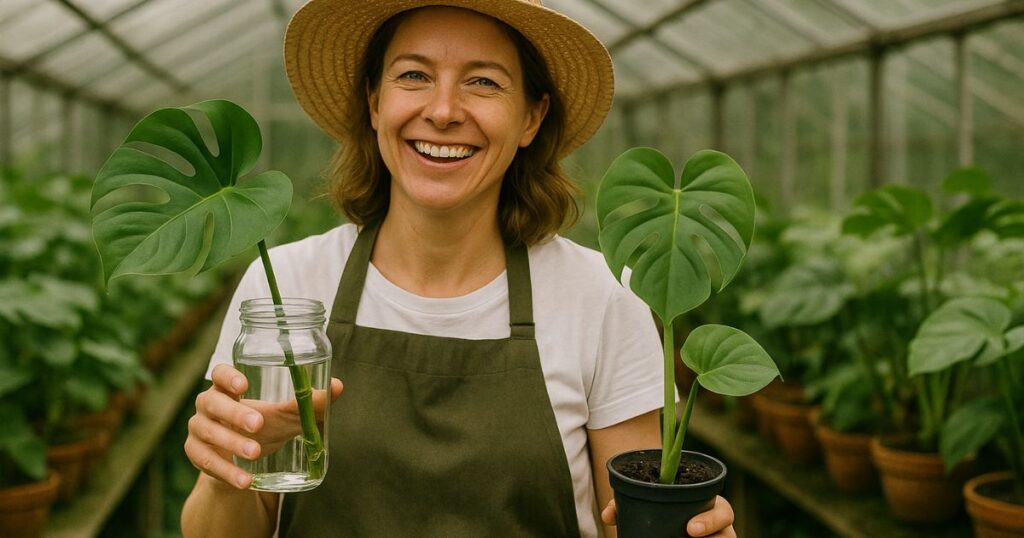
Preparing Your Cuttings
Step 1: Starting with a healthy plant that has sturdy stems and deep-green foliage is essential. A weakened Monstera parent plant, with an insect infestation or disease, will lead to unhealthy new plants.
Step 2: The next step is to remove the section of stem from the mother plant that you feel won’t leave the original plant looking too butchered or without the ability to recover. There should ideally be at least three leaves left on the mother plant after you have pruned off the section that you plan to use to propagate into new plants.
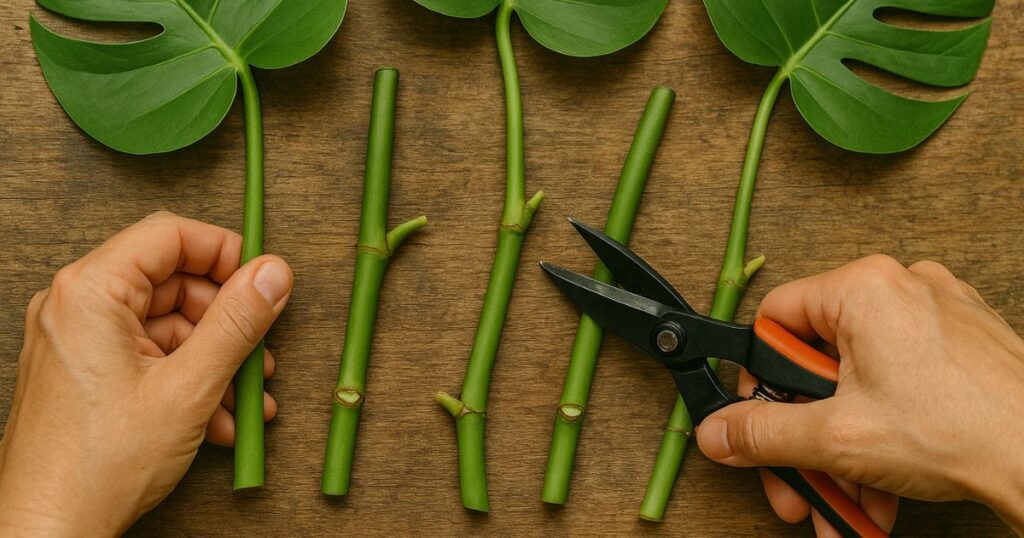
Step 3: For a “cutting” or section of the stem to be successfully transformed into a new plant, it must have one essential component, at least one “leaf node”. A “node” is a point on the stem of a plant where a leaf is growing or where it can grow from. Nodes without existing leaves can be identified by a slight bulge or a leaf scar.
From each cutting, that will grow into a new plant, roots, stems, and leaves will emerge. I like to have a minimum of two nodes per cutting – the bottom node from which roots will grow, and the top node from which new leaves and stems will grow. Ideally, each cutting will already have a leaf growing from it, and in some cases, you may be fortunate enough to have an “air root” growing out of the bottom of your cutting. If the air root is very long, you can trim it back to any length necessary to fit it into your propagation container.
Make your clean cut 1/2″ below the bottom node or “air root” and a half inch above the top “leaf node” using a clean knife. There is often a slight bulge on the stem above the point where the leaf grows from the stem, this is a “dormant stem bud” from which new stems and leaves will eventually burst forth. Under no circumstances should you damage this dormant bud by cutting through it. Once you have located the bulge where the dormant bud is located, carefully cut 1/2″ above it.

Water Monstera Propagation Method - the easiest way to propagate Monstera
When you have prepared your cuttings, which you plan to root in water (*you can use tap water or filtered water), you will want to quickly place them into the watertight container of your choice. Place the container with your Monstera cuttings in a bright sunny place in your home. Avoid putting it in a hot window where the leaves may get scorched if they come in contact with the hot glass.
If you root your cuttings in a clear glass vessel, you may end up dealing with an accumulation of algae growing on the walls of the container. You will want to clean the water occasionally. To avoid algae growth, you can put the cuttings in an opaque container that does not allow light to shine on the water. Do not add any fertilizer or anything else to the water while the roots are growing.
Once your cutting has several roots that are at least two inches in length, you can transplant it to a pot with potting soil. You will want to be extremely careful with the roots as they can be brittle and break easily.
Stake the cutting with a bamboo stake, and keep the soil well moistened while the roots make the transition from water to soil.
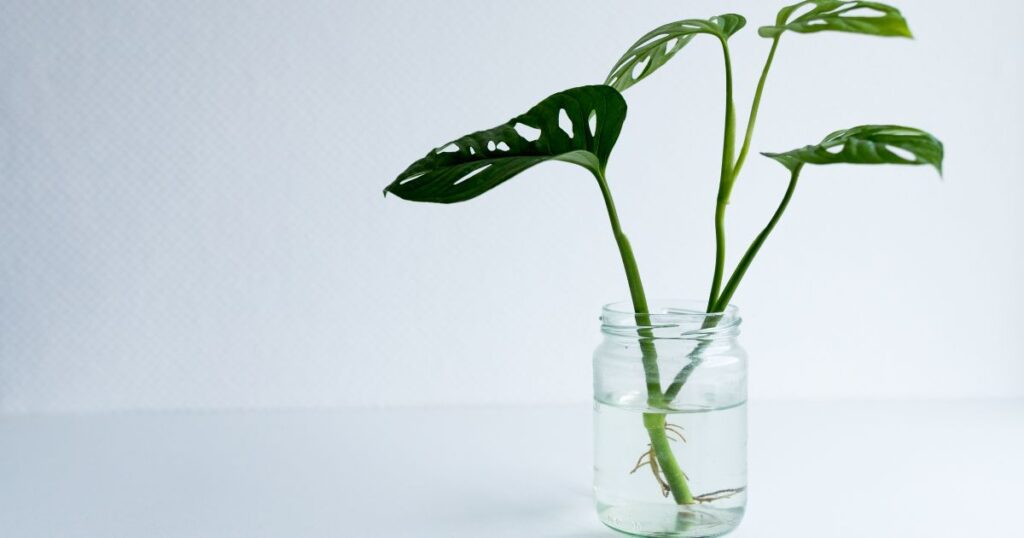
Rooting Medium Method - the best way to turn new cuttings into a whole new plant
Another easy way and very common method to propagate your split-leaf philodendron is to take your prepared cuttings, ideally with air roots already started, and place the stem cuttings into a pot with drainage holes.
Use a rooting medium that can hold moisture and hold the cutting in place while providing plenty of air circulation.
While some gardeners like to use rooting hormone, I find that these plants grow so easily that they don’t require the addition of rooting hormone.
Moist sphagnum moss, perlite mixes, and an airated potting soil all make excellent options for rooting Monstera cuttings. Keep the rooting medium moist but not soggy.
When your Monstera cuttings have rooted well, in about 2-3 weeks, they can be transplanted into a larger container with a high-quality houseplant potting soil.
As Monstera are tropical plants, native to warm climates with lots of rain and humidity, they like to be watered regularly. Allow the soil to nearly dry out between waterings and place them in a part of your home that gets plenty of indirect light.
You can grow Split-leaf philodendron (Monstera deliciosa) in direct sunlight as long as it’s mainly morning or shaded sunlight, but ideally not hot afternoon sun.

List Of Supplies
• Strong Clippers or Pruning Shears – to make the cuttings
• Glass Vase at least 6″ tall and 4″ wide – to use for water propagation
• 4″ Clay Pot – to use for rooting medium propagation
• Perlite, Sphagnum Moss, Peat Moss Free Potting Soil – used for rooting medium
• Bamboo Stakes 14″ to 18″ (orchid stakes work well) – to stabilize the cuttings while rooting
• Houseplant Potting Soil – for after your new Monstera plants have rooted
• Moss pole – to train the new growth, main stem, and large leaves of your Monstera ( Split-leaf philodendron ) on so that it doesn’t so that it doesn’t flop all over the place is a very good idea
You May Now Consider Yourself An Expert On How To Propagate Monstera Plants
By following these simple step-by-step instructions, the leaf starts you propagate from your Monstera (one of the most popular houseplants ), will allow you to fill your home from your living room to your bathroom with scores of these high humidity-loving plants.
Now that you know how to propagate Monstera plants, I’d like to share some tips on how to grow Monstera plants successfully at home.
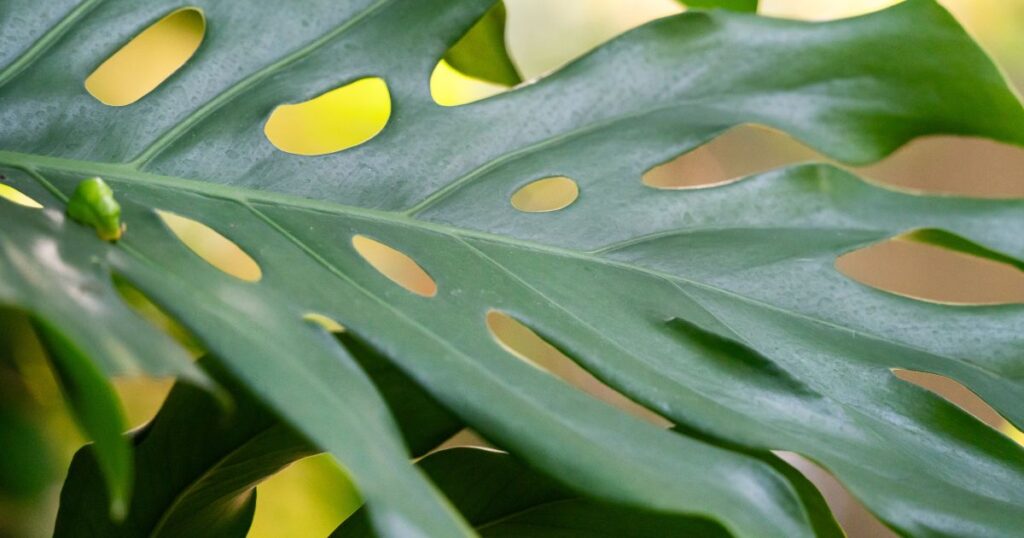
General Growing Tips For Growing A Healthy Monstera deliciosa (Split-leaf philodendron)
Monstera deliciosa, also known as the split-leaf philodendron, is a tropical plant grown for its large, fenestrated leaves. It does well indoors with the right conditions. How do you keep your Monstera healthy and growing year-round?
Light
These tropicals prefers bright, indirect light. Direct sun can scorch the leaves. Low light slows growth and limits leaf splits. Is your plant near a window but out of direct sun? That’s usually the right spot.
Soil
The right soil helps prevent overwatering and root rot. Monstera grows best in a loose, well-draining mix. Use a blend of potting soil, perlite, and orchid bark. This gives roots airflow and drains extra water. Regular potting soil on its own holds too much moisture.
Watering
Let the top inch or two of soil dry before watering. Stick your finger in the soil. If it feels dry, it’s time to water. Don’t water on a fixed schedule—watch the plant instead. Yellowing leaves? That might be too much water. Crisp edges? That could mean too little.
Humidity and Temperature
Monsteras prefer warm, humid air. Room temperature works, but growth slows below 65°F. Dry air can make leaf edges brown. Do you live in a dry area? Try a humidifier or place your plant near other houseplants to raise the moisture in the air.
Potting
Use a pot with drainage holes. Roots need space, so repot every 1–2 years. If the roots circle the bottom or grow out of the holes, it’s time for a bigger pot. Move up just one size to avoid waterlogged soil.
Support
As Monstera grow upward and benefits from support. Use a moss pole or stake. This helps the plant stay upright and develop larger, split leaves. Tie stems loosely with garden ties if needed.
Fertilizer
Monstera needs nutrients during its growing season, usually spring through early fall. You can use either liquid or granular fertilizer. Which one is better for you?
Liquid fertilizers are mixed with water and applied during regular watering. They’re quick-acting and allow you to control the dose. If you like adjusting care based on growth, liquid might be the way to go.
Granular fertilizers are slow-release. They’re mixed into the soil and break down over time. This gives steady feeding with less effort. If you prefer low-maintenance care, granular could work better.
Choose a balanced fertilizer with equal N-P-K values (like 10-10-10 or 20-20-20). You can also use one higher in nitrogen if your plant is pushing out lots of new leaves.
Cleaning and Pruning
Dust builds up on large leaves. Wipe them with a damp cloth every few weeks so the plant can absorb more light. Trim off yellow or damaged leaves at the base. Want to shape your plant? Cut above a leaf node, and new growth will form there.
Pests
Monstera can get spider mites, mealybugs, or scale. Check leaves often, especially under them. If you spot bugs, wipe them off or use insecticidal soap. Catching them early makes a big difference.
Growth Tips
Is your Monstera not growing? Look at light, water, and nutrients. Is it rootbound? Is it too cold? Small changes can restart growth. Watch how the plant reacts and adjust care as needed.
With the right care, your Monstera will keep growing new leaves and stay healthy for years. What will yours look like in six months? Keep it simple, stay consistent, and your plant will respond.
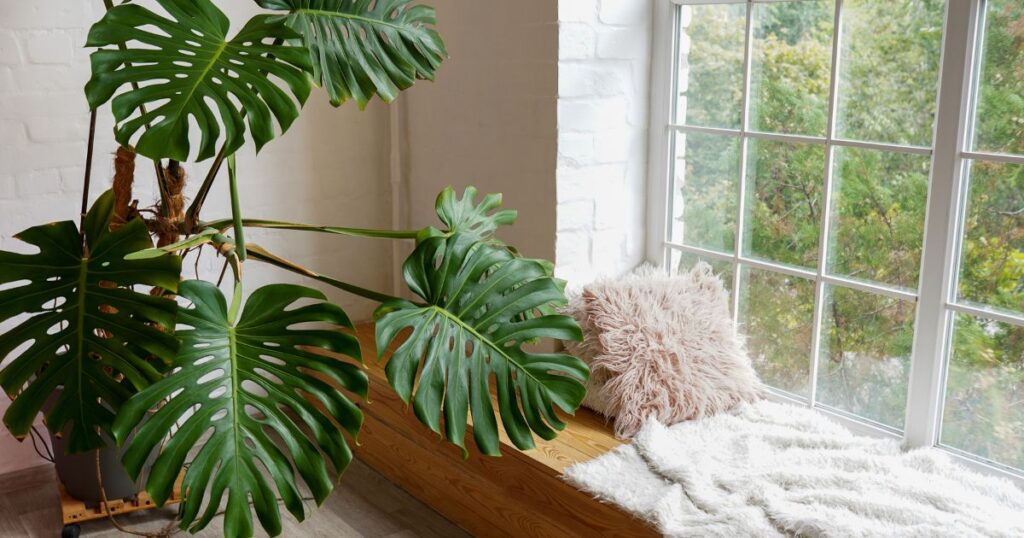
With All The Points We've Covered, You Now Know How To Grow And How To Propagate Monstera Plants
Whether you’re a brand-new plant parent or if you’ve been gardening for years, if you’ve been wanting to grow or propagate Monstera plants there’s no better time than the present.
These forgiving plants are a very good way to break into the fascinating world of plant propagation.
Best of luck to you and your plants!
Cheers,
– Nathan Heinrich

Best Fertilizer For Endless Summer Hydrangeas
The old-fashioned and ever-popular big leaf hydrangeas have been regulars in royal and cottage gardens for centuries, but about 20 years ago a new and improved version of the classic hydrangea made its debut in the world of gardening.

Best Hydroponic Racks For Indoor Hydro Grow Rack System
Best Hydroponic Racks For Indoor Hydro Grow Rack System Hydroponic Racks – How To Grow More Using Less Space – A Greenhouse Grower Shares His

Best Carbon Filter For Grow Tent: Your Filters Review
Best Carbon Filter For Grow Tent: Your Filters Review Best Carbon Filter for Grow Tent: A Horticulturist’s Guide To Finding The Right Filter For Your

Best Hydroponic Fertilizer: Top Hydroponics Nutrients
Best Hydroponic Fertilizer • Top Hydroponics Nutrients Best Hydroponic Fertilizer: A Botanist’s Guide To The Best Nutrients For Hydroponic Growing Systems In Your Home Or
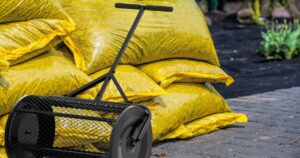
Best Compost Spreader: Top Spreaders For Your Lawn
Best Compost Spreader: Top Spreaders For Your Lawn And Garden A Horticulturist And Landscape Designer With Over 30 Years Of Experience Shares His Top Tips

How To Propagate Monstera Plants: Your Easy Guide
How To Propagate Monstera Plants: Your Easy Guide Learn How To How To Propagate Monstera Plants From A Gardening And Propagation Expert Who Specializes In

Nathan is a writer, designer, and horticulturist. Son of a 5th-generation California farming family, Nathan has a lifelong love for growing things. Nathan splits his time between his farms in Southern Tennessee and Central Italy, where he shares, weekly articles and videos about farming, gardening, botanical design, and more.

One Response